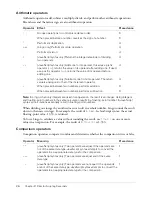
Data types
15
•
Case-sensitivity can vary between Lingo and JavaScript syntax.
Lingo is not case-sensitive in any circumstance—you can use uppercase and lowercase letters
however you want. For example, the following four statements are equivalent:
-- Lingo syntax
member("Cat").hilite = true
member("cat").hiLite = True
MEMBER("CAT").HILITE = TRUE
Member("Cat").Hilite = true
Although Lingo is not case-sensitive, it’s a good habit to choose a case convention and use it
consistently throughout your scripts. This makes it is easier to identify names of handlers,
variables, cast members, and so on.
JavaScript syntax is case-sensitive when referring to objects, the top level properties or methods
that refer to objects, or when referring to user-defined variables. For example, the top level
sprite()
method returns a reference to a specific Sprite object, and is implemented in
Director with all lowercase letters. The first statement below refers to the name of the first
sprite in a movie, while the second and third statements result in a script error.
// JavaScript syntax
sprite(1).name // This statement functions normally
Sprite(1).name // This statement results in a script error
SPRITE(1).name // This statement results in a script error
Literal strings are always case-sensitive in both Lingo and JavaScript syntax.
For more information on using strings, see
“Strings” on page 18
.
Data types
A data type is a set of data with values that have similar, predefined characteristics. Every variable
and property value in Director is of a specific data type, and values returned by methods are of a
specific data type.
For example, consider the following two statements. In the first statement, variable
intX
is
assigned a whole number value of 14, which is an integer. So, the data type of variable
intX
is
integer. In the second statement, variable
stringX
is assigned a sequence of character values,
which is a string. So, the data type of variable
stringX
is string.
-- Lingo syntax
intX = 14
stringX = "News Headlines"
// JavaScript syntax
var intX = 14;
var stringX = "News Headlines";
The values that are returned by methods or functions are also of an inherent data type. For
example, the Player object’s
windowPresent()
method returns a value that specifies whether a
window is present. The returned value is
TRUE
(1) or
FALSE
(0).
Содержание DIRECTOR MX 2004-DIRECTOR SCRIPTING
Страница 1: ...DIRECTOR MX 2004 Director Scripting Reference...
Страница 48: ...48 Chapter 2 Director Scripting Essentials...
Страница 100: ...100 Chapter 4 Debugging Scripts in Director...
Страница 118: ...118 Chapter 5 Director Core Objects...
Страница 594: ...594 Chapter 12 Methods...
Страница 684: ...684 Chapter 14 Properties See also DVD...
Страница 702: ...702 Chapter 14 Properties See also face vertices vertices flat...
Страница 856: ...856 Chapter 14 Properties JavaScript syntax sprite 15 member member 3 4...
Страница 889: ...netPresent 889 _player alert Sorry the Network Support Xtras could not be found See also Player...
Страница 1102: ...1102 Chapter 14 Properties...
















































